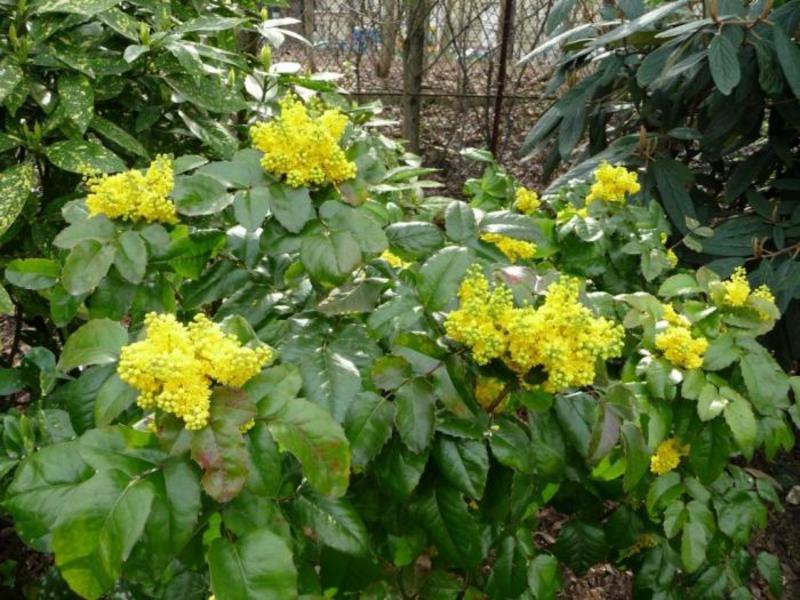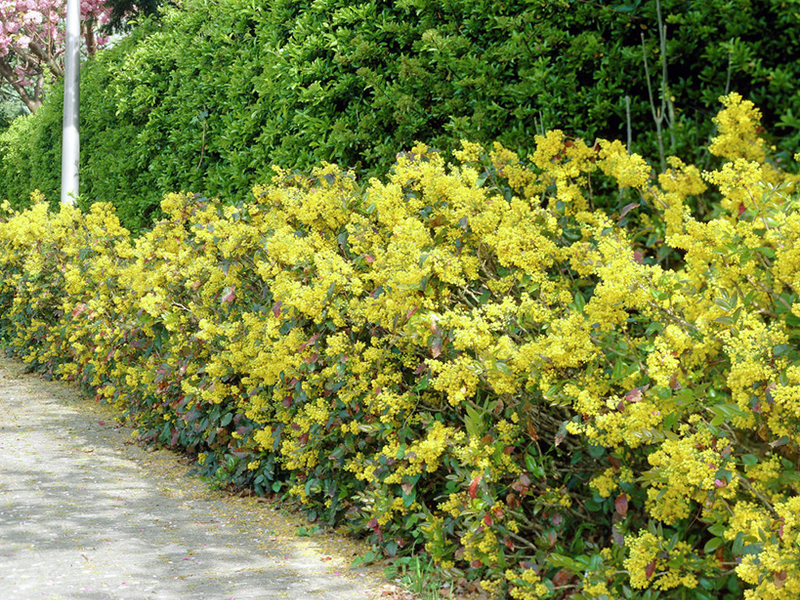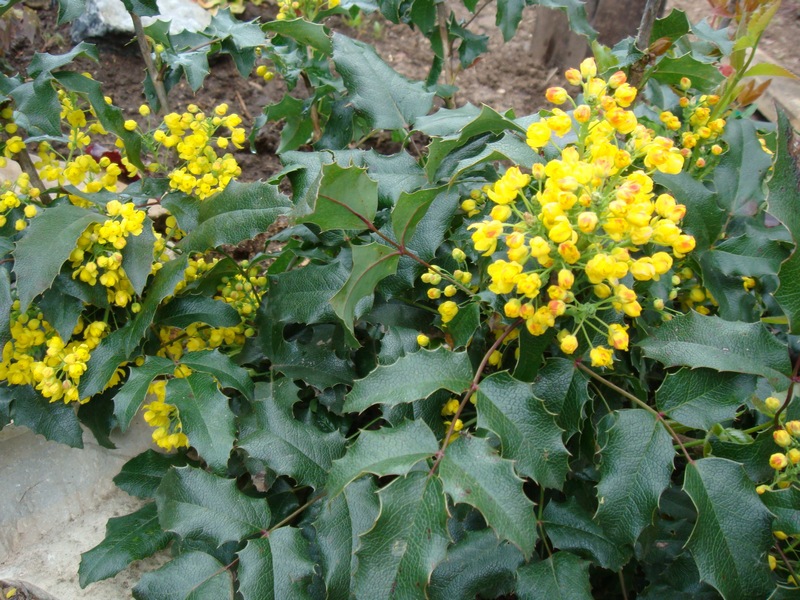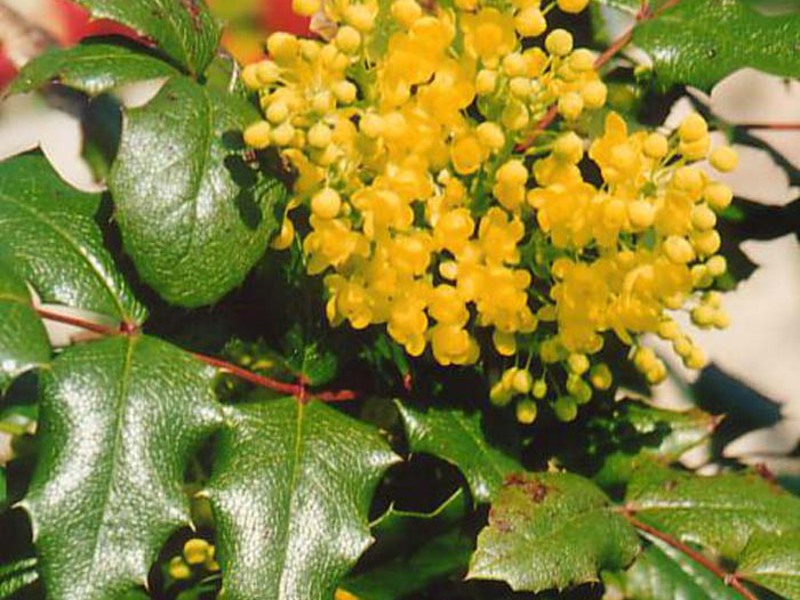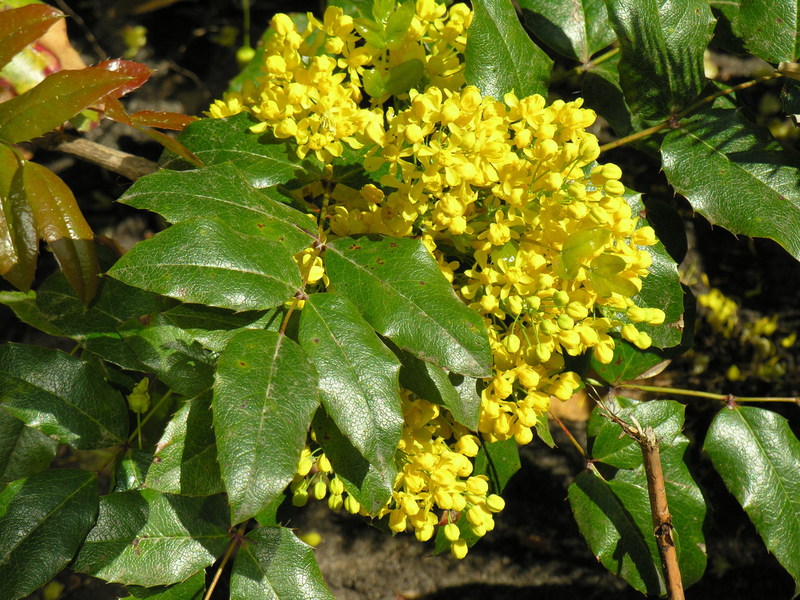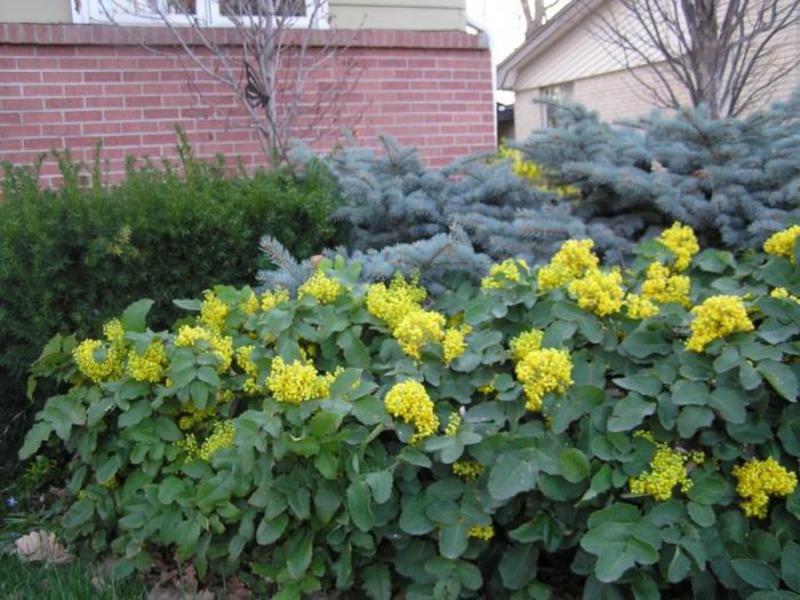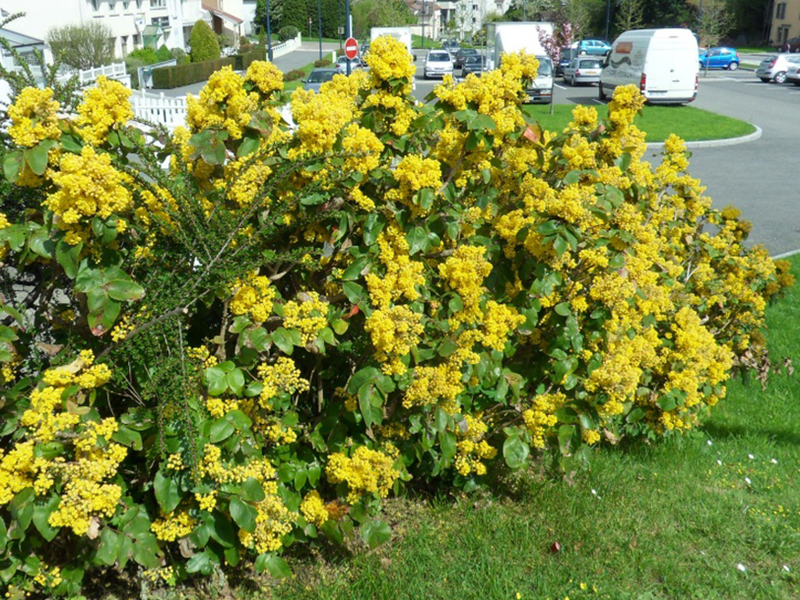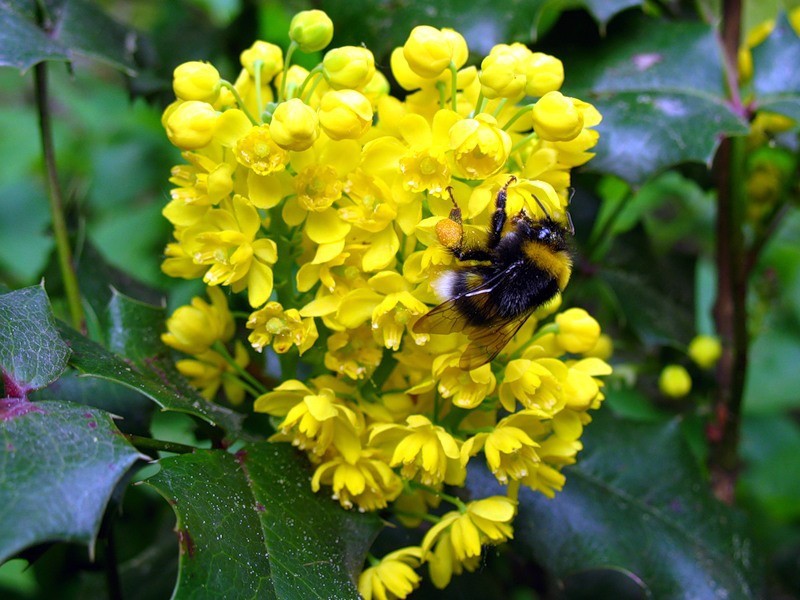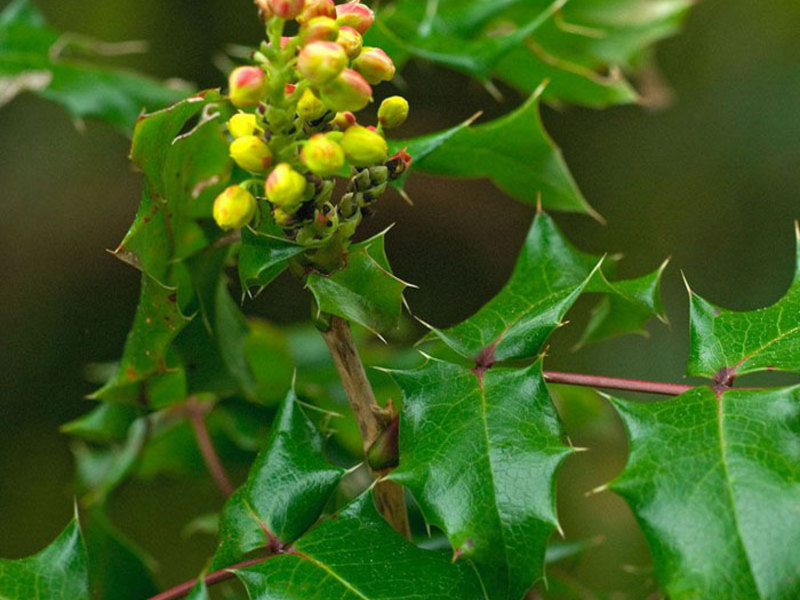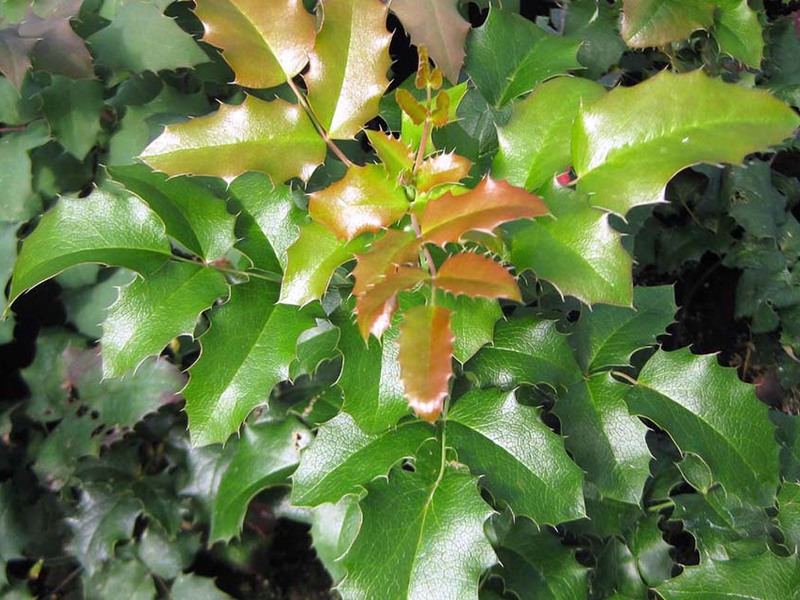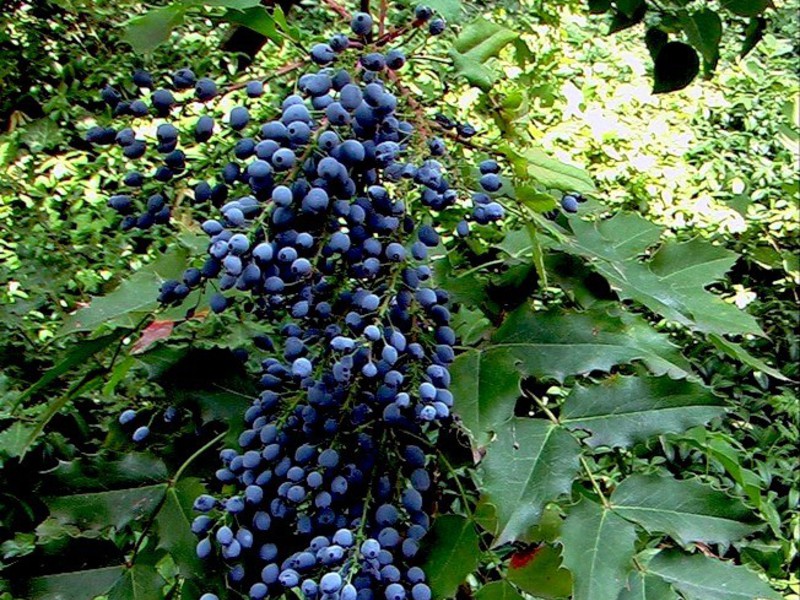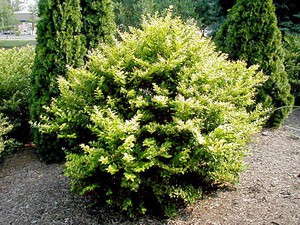 Mahonia holly is one of the interesting representatives of the barberry family, which differs from other species in stunting. In total, about 50 species are represented in the genus of this evergreen shrub. The homeland of Mahonia holly is the North American continent, but this is not a serious obstacle to its cultivation in the temperate climate of the middle latitude of our country.
Mahonia holly is one of the interesting representatives of the barberry family, which differs from other species in stunting. In total, about 50 species are represented in the genus of this evergreen shrub. The homeland of Mahonia holly is the North American continent, but this is not a serious obstacle to its cultivation in the temperate climate of the middle latitude of our country.
In its homeland, the plant is known as "Oregon grapes"... Until 1822, its representation was limited only to its native places, but later it was brought to the European continent, where it continues to grow today, widely used in landscape design.
Content
What did Mahonia like to gardeners?
A photo of a plant can already arouse interest. Therefore, a rare gardener remains indifferent to the beauty of the leathery leaves of Mahonia, which it retains unchanged throughout almost the entire growing season. Seeing for the first time its leaves, their can be mistaken for holly leaves, which, in principle, explains the name of the plant. In the spring, when the leaves begin to bloom, they are reddish in color. However, in summer it changes to dark green, and in autumn, when the growing season comes to an end, they acquire a golden-bronze hue.
The stems of Mahonia become even more beautiful at the moment of the onset of the first frost, which change its color to purple.
Such a variety of color palette is one of the reasons for the increased interest of many gardeners in this plant, which is often used in landscape design. Therefore, when decorating their sites, they often choose Mahonia. The plant fits perfectly into the design of the rock garden, and can also be presented as part of various group compositions, including lawn areas. With the help of Mahonia, you can ennoble various buildings if you plant it next to them. It also allows you to highlight the greenery of the gardens. Since Mahonia is a short plant, it can be successfully used as a curb plant or a low hedge.
In the process of development, Mahonia holly appears a lot outgoing root suckers, therefore, during the season, it can form small thickets. In this regard, Mahonia seems to be an excellent option for decorating those areas where it is necessary to fill the soil surface.
Characteristics of Mahonia holly
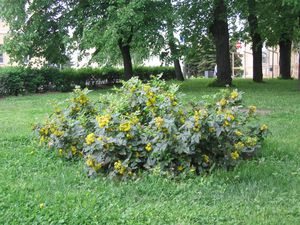 In the flowering phase, a pleasant and light aroma emanates from this plant, and it itself looks like lily of the valley flowers. The first flowers open in May and remain so until June. They usually have a yellow tint and form small cluster inflorescences. If the autumn is warm enough, then the gardener gets an additional opportunity to admire the blooming Mahonia in October.
In the flowering phase, a pleasant and light aroma emanates from this plant, and it itself looks like lily of the valley flowers. The first flowers open in May and remain so until June. They usually have a yellow tint and form small cluster inflorescences. If the autumn is warm enough, then the gardener gets an additional opportunity to admire the blooming Mahonia in October.
This flower is one of the cross-pollinated plants, so it can bloom only if there is a paired specimen.Without this, fruits that provide planting material for reproduction will not be able to form. This plant ripens oval fruits, which are up to 1 cm long. Most often they reach the stage of maturity in August, which can be determined by their dark blue color.
Mahonia berries have a pronounced sweet and sour taste, which they resemble barberry. The fruit contains a small amount of pulp and many seeds.
You should not immediately consume berries in food - it is better to let them lie down for a while in the refrigerator. Then their taste will change for the better. Mahonia berries may not fall off for a very long time, up to five months, since this the dense stalk saves... And even if you delay the harvest, it will not lead to the decomposition of vitamins and other organic compounds. Up to 2 kg of fruit can be harvested from one plant per season.
Planting Mahonia holly
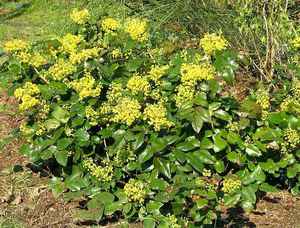 Considering that holly mahonia is most often found in forests, it is better to grow it in shaded areas under artificial conditions. If Mahonia grows in sunny areas, direct sunlight can cause burns, which will significantly weaken the plant and slow down its growth. Most suitable for growing Mahonia are places protected from the wind, which are in partial shade created by neighboring buildings or trees.
Considering that holly mahonia is most often found in forests, it is better to grow it in shaded areas under artificial conditions. If Mahonia grows in sunny areas, direct sunlight can cause burns, which will significantly weaken the plant and slow down its growth. Most suitable for growing Mahonia are places protected from the wind, which are in partial shade created by neighboring buildings or trees.
Mahonia is undemanding to the quality of the soil and its fertility. therefore you can grow it on any soil.
To obtain dense thickets of Mahonia holly during planting, it is recommended to place the plants no further than 1 m from each other. You can create more sparse plantings if the distance between plants is increased to 2 m.
During planting, the bushes need to be buried to a depth of no more than 50 cm. After transferring the plant to the hole, the root collar should be strictly at the soil level. The planted bushes of Mahonia holly must be watered well.
Plant care
It is not difficult to grow holly Mahonia in open field conditions also because it does not create problems in care. Regular watering is just one of the activities that are necessary for the normal development of plants. It is also recommended to periodically feed with a solution of complex mineral fertilizers.
Rules for caring for Mahonia holly:
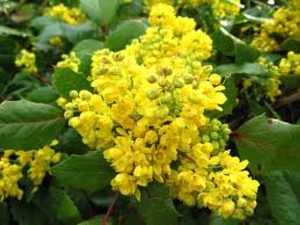 for the first time, fertilizers are applied under the bushes in May, which is usually done even before flowering;
for the first time, fertilizers are applied under the bushes in May, which is usually done even before flowering;- in order to avoid the opposite effect, it is necessary to adhere to the consumption rate - no more than 100 g / sq. m .;
- If Mahonia is grown in arid places, then it must be watered abundantly. It is useful to regularly mulch the trunk circle, which will help better retain moisture in the soil;
- the transplant does not injure the plants, so it can be carried out on any plants, regardless of the current season and the age of the bush. True, it is not recommended to transplant Mahonia in late autumn, because in order to winter without consequences, it needs to accumulate enough strength;
- Mahonia feels best in shading conditions, so its bushes will grow well next to any object that can protect it from direct sunlight;
- In preparation for winter, Mahonia holly may require shelter in areas where winters with little snow often occur. If in winter there is enough snow in the place where Mahonia is grown, then you will not need to use covering materials, since a dense snow cover will provide good protection from cold weather;
- Mahonia is highly resistant to pathogens and fungi.
Useful pruning periodicallythat will help maintain a beautiful or sophisticated form of Mahonia holly. Planting and care that includes this event will help the plant to show its full beauty.
Spring pruning is recommended.In this case, only those shoots and stems that do not have flower buds will be subject to removal. Carrying out pruning taking into account this point will avoid disturbing the abundant flowering of the bush.
Plants tolerate pruning well, after which it takes not much time to recover. As a rule, the bushes regain their previous shape due to the formation of young shoots.
Reproduction of Mahonia holly
To obtain young bushes, you can use propagation methods such as sowing seeds, growing from root suckers and cuttings. It is recommended to use the method of sowing seeds in spring, and it must be germinated seeds.
Propagation by cuttings
Also acquire Mahonia bushes on the site you can use cuttings:
- it is recommended to choose green shoots and stems with leaves as planting material;
- the stems are used for harvesting shortened cuttings, which must necessarily have a straight upper cut and an oblique lower cut;
- so that the cuttings take root faster, it is recommended to apply a solution of root growth stimulants to the lower cut;
- after preparation, the cuttings are buried in the ground, not forgetting that the lower bud should be at ground level;
- after that, the topsoil must be thoroughly tamped and poured with a fungicidal solution to protect against diseases;
- after planting, plastic bottles with transparent walls are installed on the cuttings, thorough watering is mandatory.
Reproduction by layering
Get planting material in spring Mahonia holly can also be from layering:
 for this, the most developed shoots are used, which must be jumped as close as possible to the surface of the soil and covered with earth. As a result of this operation, the tip of the shoot should protrude from the soil;
for this, the most developed shoots are used, which must be jumped as close as possible to the surface of the soil and covered with earth. As a result of this operation, the tip of the shoot should protrude from the soil;- in the place where the shoot is located underground, a wire is buried to fix the shoot, which will subsequently help to provide favorable conditions for the formation of the root system;
- after completing the basic steps, it is necessary to thoroughly water the tubercle of soil that has arisen on the surface;
- By the fall, a seedling with well-developed roots is formed from the bent shoot, which can be separated from the mother plant and transplanted to a permanent place.
Conclusion
Mahonia holly has many fans from among experienced florists. This plant has beautiful leaves and inflorescences, therefore, Mahonia holly is increasingly used in landscape design. However, due to the fact that it is shade-tolerant, it is most often grown near the various objects that are in the garden. In addition to protection from direct sunlight, Mahonia needs regular watering, which is especially true in areas where long periods of drought are often observed. Otherwise, it demonstrates unpretentiousness, so it can be grown on any soil.
